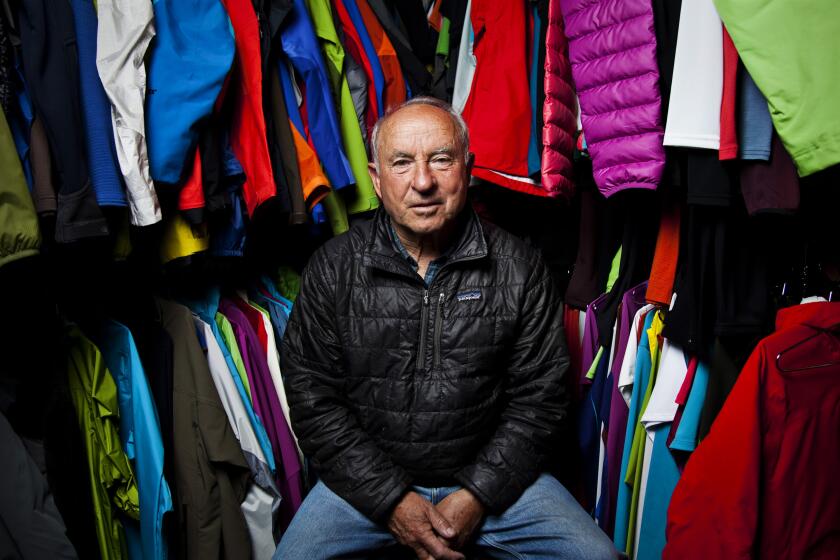The race to waterproof outdoor gear — without toxic chemicals

- Share via
Patagonia Inc. has spent nearly a decade rejiggering its supply chain, redesigning products and dumping millions of dollars into a high-stakes trial-and-error process that’s nearly complete.
For the Ventura outdoor clothing retailer, this isn’t about optimizing for fashion.
Patagonia, like practically every other outdoor apparel company, has long relied on per- or polyfluorinated chemicals — PFAS for short — to make its products water-resistant.
The problem is that these chemicals, also known as fluorochemicals, PFC chemicals or forever chemicals, are toxic. They’ve been linked to cancer and other health problems and they don’t degrade easily: PFAS have been found in drinking water and in the human bloodstream.
Despite years of warnings from scientists and environmental activists, many apparel retailers only recently started sussing out how to ditch PFAS in outdoor apparel and gear. But the stragglers may not be able to straggle much longer: Bans on the chemicals are coming.
Yvon Chouinard has always said Patagonia’s mission was to protect nature. In donating his shares to a trust and a nonprofit, he ensures his life’s work will continue.
“We were looking for a magic chemistry that could do it all and get our performance back and keep your jacket waterproof,” said Matt Dwyer, Patagonia’s vice president of product impact and innovation. “And it took a whole lot more work than that.”
The PFAS problem has been decades in the making.
In the 1950s, Minnesota-based chemical maker 3M Co. launched Scotchgard, which used fluorochemicals to make fabrics water- and stain-repellant.
Within a few decades, the chemicals were ubiquitous in outdoor apparel and gear. That’s because “they just blew everything apart in terms of how well they worked,” said Richard Blackburn, a professor of sustainable materials at the University of Leeds.
These chemicals can repel water as well as, if not better than, any alternative, he said. If water is poured on a textile treated with PFAS, it just rolls or beads off. And unlike the alternatives, fluorochemicals also effectively repel oil, dirt and other stains.
“From a chemical perspective, they are fantastic,” Blackburn said.

But that resilience is also a liability.
Mike Schade, a campaign director with the environmental group Toxic-Free Future, notes that PFAS are harmful across their life cycle: The manufacturing phase can affect factory workers and local water systems, while washing and owning jackets and other products coated with PFAS can potentially harm consumers.
Indeed, 3M had known the chemicals were found in the blood of the general population and detected at elevated levels in its own workers by the mid-1970s. But exactly what 3M knew about the dangers of PFAS wasn’t publicly revealed until decades later following investigations and litigation.
“One of the reasons we’re concerned about PFAS is because they’re incredibly persistent chemicals,” Schade said. “They’re manufactured for food packaging or firefighting foam or rain jackets, and the chemicals don’t go away when they’re released into the environment. They can persist literally for hundreds of years.”
A key turning point, according to Blackburn, was Greenpeace’s Detox campaign in the mid-2010s, which started publicly targeting some outdoor apparel companies about their use of fluorochemicals. The environmental group tested 40 items for forever chemicals and found them in all but four, exposing an industry-wide problem.
That campaign had an effect on apparel makers in Europe: Jack Wolfskin announced its clothing, packs and bags were “100% PFC-free” by mid-2019; Vaude Sport announced its clothes and gear were PFC-free by 2020; and Haglofs is now “95% PFC free.” But in the U.S., and the rest of the world, an abundance of rain gear and outdoor equipment with PFAS is still in circulation.
From climate change to voting rights, Patagonia has been willing to risk backlash by taking positions on contentious social issues. It’s a risk that has paid off.
Patagonia initially transitioned away from what’s called “long-chain” PFAS chemicals, including PFOA and PFOS, to “short-chain” ones — completing the swap for products in stores by mid-2016. At the time, the thinking was that short-chain chemicals were safer; testing and scientific study into long-chain chemicals was more extensive.
But as the transition was underway, Dwyer said the company realized this was not “just an imperfect solution, but was a solution possibly as bad as the ones that we’d replaced.” So the journey to go totally PFAS-free began, and quickly proved daunting.
The first fabrics the company tested with PFC-free chemistries in 2015 “were stiff as paper and you could rip them in half,” Dwyer said. After hundreds of sample trials testing out dozens of different chemistries, Patagonia is today using about eight different PFAS alternatives for water-resistance on its various products sold worldwide.
The company is aiming for all products on its shelves to be “PFC-free” by the end of 2024 and announced last fall that 78% of its materials was already there.
A few other companies are also making progress, but a survey of 15 apparel and outdoor apparel brands on their PFAS use yielded a wide spectrum of results.
Eager to escape claustrophobic pandemic life and take advantage of newly remote jobs, increasing numbers of Americans are taking to remote places in rugged vehicles that are also homes.
Outerwear company Rains publicly reports not using these chemicals today, either because they never did or already phased them out. (The company did not respond to Bloomberg’s questions.) Swedish company Fjällräven says it has moved away from PFAS in all of its products, though the last of the new versions won’t be available to consumers until later this year.
Eight companies have announced plans to transition away from PFAS in the coming years, including Canada Goose Holdings Inc. Columbia Sportswear Co., Cotopaxi, W.L. Gore & Associates, Patagonia, Lululemon Athletica Inc., L.L.Bean Inc. and VF Corp.
Lululemon aims to do so by the end of this year. Eddie Bauer Inc. said it plans to remove PFAS from all products by spring 2024.
Adidas AG, Arc’teryx Equipment Inc., Nike Inc. and Vuori Inc. have not shared specific phase-out targets publicly or in response to Bloomberg’s repeated questions.
When Greenpeace contacted Fjällräven in 2012 about finding forever chemicals in its products, the outdoor apparel company had, as far as its executives knew, already stopped using PFAS in those items.
“I said, show me your test results, and I went to the Greenpeace headquarters in Germany,” said Aiko Bode, operating sustainability director at Fjällräven. The activists were right. “S—, something must have happened,” Bode recalled.
California Atty. Gen. Rob Bonta announced that the state has sued the manufacturers of ‘forever chemicals’ such as PFAS, which are linked to cancer.
His follow-up investigation first revealed that a supplier using fluorochemistry on another company’s products was cross-contaminating Fjällräven’s, prompting a reorganization of Fjällräven’s suppliers. Subsequent testing revealed that simply having Fjällräven products in stores near products from other companies that used the chemicals still resulted in low levels of contamination.
One of the biggest challenges for the brands ditching PFAS is coordination across large and often complex supply chains.
Cotopaxi, a Salt Lake City-based outdoor apparel brand, makes gear that includes bags, hats and jackets — but has stayed away from producing high-performance rain gear because of high PFAS chemical content. Still, an internal testing process identified three Cotopaxi products that contain traces of PFAS, which the company is hoping to phase out this year.
“What we’re worried about with this issue is that Western brands aren’t going to allow their suppliers the opportunity to help source new chemistry needed to meet [regulations],” said Annie Agle, Cotopaxi’s senior director of impact and sustainability. “That could make them go out of business.”
Despite its contamination struggles, Fjällräven did ultimately figure out how to eliminate forever chemicals from the manufacturing process. In 2015, it started making its waterproof Keb Eco-Shell jacket using a PFAS alternative; by the middle of this year, even the zippers will be fluorochemical-free.
And the company tapped another pre-existing alternative — a paraffin/beeswax mix — for its “cornerstone material,” G-1000, which is made of recycled polyester and organic cotton. The trade-off on that, Bode said, was settling for products that don’t repel water quite as well as those coated with forever chemicals.
“If you go through just what normal people do, going through a fog, going through a forest, walking the dog, it works very well,” he said. But if you are hiking through two hours of heavy rainfall, for example, “you will not be dry.”
Environmental and health groups are pushing fast-food companies, supermarket chains and other retail outlets to remove PFAS from their packaging.
That loss of function is behind some companies’ reluctance to move away from forever chemicals, said Blackburn, who also calls all the added functionality “overengineering.” Blackburn’s research backs this up: An online survey of nearly 1,000 outdoor enthusiasts, most of them from Britain, found that they essentially only cared about water repellency.
“If you only want water repellency, there are much more sustainable technologies that work and deliver technically,” Blackburn said. “If you also want combined oil repellency then no, you can’t achieve that yet with any alternative chemistry.”
Representatives of Adidas, Columbia Sportswear and North Face-owner VF Corp., all of which are partway through their transitions away from forever chemicals, likewise noted that finding PFAS alternatives in high-performance jackets and other products designed for extreme environments is the most challenging task.
W.L. Gore & Associates (maker of Gore-Tex, a waterproof fabric used widely across apparel and footwear that has historically been found to contain PFAS) said it’s currently working to scale the use of a PFAS alternative known as ePE, which has been in development for a decade. The company said it is on track to transition the “vast majority” of its consumer portfolio away from harmful chemicals by the end of 2025.
Time is of the essence: Faced with indisputable science and increasing pressure to address environmental harms, governments are starting to catch up with PFAS.
In the U.S., roughly a dozen states already have policies banning or strictly regulating these chemicals in various products, including firefighting foam, rugs and cosmetics, according to tracking by an alliance of health organizations called Safer States.
These gifts are for those who love to hike, camp and trail run — or those who just want to picnic on a nice blanket or take a joy ride with their dog.
More restrictions are coming online or being discussed specifically for textiles.
In California, a law passed last year bans the manufacture, distribution and sale of some fluorochemical-containing textiles for everyday use starting in 2025.
A Maine law that took effect in January requires brands to disclose to state environmental officials whether PFAS is used in their products; the chemicals will be banned in the state entirely by 2030. Washington state will ban PFAS in many consumer products, including apparel, by 2025. New York will also implement a ban on most apparel containing these chemicals by 2025.
The federal government, meanwhile, has been accused of “foot-dragging” on establishing meaningful protections.
In 2020, the Environmental Protection Agency halted the use of long-chain PFAS in the manufacture, processing or importing of many consumer products pending agency review; more restrictions are anticipated in the future. In the European Union, six countries submitted a proposal last month that would restrict the manufacture and use of PFAS across several product categories.
There are also growing legal threats.
A cheeky hidden message is the company’s latest call to action on climate change and protecting public lands.
Recreational Equipment Inc., more commonly known as REI, was hit with a proposed class-action lawsuit in October alleging that it deceptively markets certain waterproof garments as “sustainable” despite the presence of harmful PFAS; the suit is still pending.
Menstrual underwear brand Thinx reached a $5-million settlement last year following a class-action lawsuit alleging that its products contain PFAS chemicals. Thinx denied the allegations.
Following litigation of its own, 3M said in December that it will stop manufacturing PFAS by 2025, citing “accelerating regulatory trends focused on reducing or eliminating the presence of PFAS in the environment and changing stakeholder expectations.”
As the urgency around eliminating PFAS gains steam, companies that have made little progress thus far are effectively already behind.
Fast-fashion retailers may be able to roll out new clothing lines in just a few months, but the rest of the apparel world takes one or more years to go from product design to store-ready. That means companies aiming to heed upcoming bans need to start addressing their supply chain as soon as possible.
“Our chemical crystal ball told us that these regulations and things like that were going to happen at some point,” said Dwyer at Patagonia, which is already working on its 2025 products. “Now we know they’re in the very near future.”
More to Read
Inside the business of entertainment
The Wide Shot brings you news, analysis and insights on everything from streaming wars to production — and what it all means for the future.
You may occasionally receive promotional content from the Los Angeles Times.














